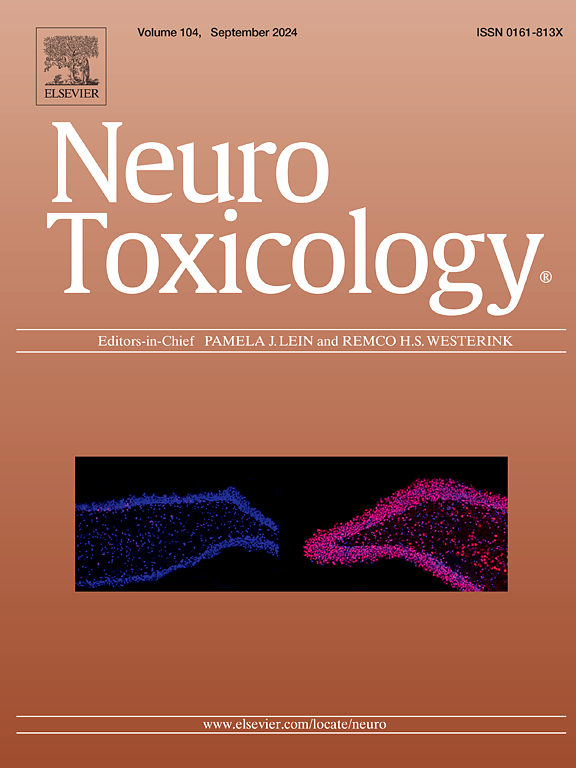Silver nanoparticle (AgNP), neurotoxicity, and putative adverse outcome pathway (AOP): A review
IF 3.9
3区 医学
Q2 NEUROSCIENCES
引用次数: 0
Abstract
Various silver nanoparticles (AgNPs) exist with different sizes, coatings, and shapes. AgNPs have unique physical and chemical properties, such as high surface-to-volume ratio and antimicrobial properties, which allow them to be used in a wide array of applications in consumer products and medical applications, including clothing, cosmetics, food packaging, medical devices, and wound dressings. They are also one of the most studied engineered nanomaterials (ENMs). Though the liver and lung have been identified as the primary targets of AgNP exposures, an increasing number of studies have reported accumulations of AgNPs in the brains of AgNP-exposed animals. These findings have raised concerns because the brain plays a critical function in our body and may have difficulty clearing AgNPs, unlike the liver and lung. Studies have been conducted to investigate potential neurotoxicity effects of AgNP exposures, but they use various types of AgNPs and routes of administration, which makes it difficult to compare across studies. Therefore, the goal of this review was to (1) assess factors that may affect AgNP-induced neurotoxicity, (2) identify potential mechanisms of neurotoxicity exerted by AgNPs, (3) review existing in vitro dose-response and in vivo exposure-response AgNP-induced neurotoxicity studies, and (4) provide an example application of benchmark doses (BMDs) in comparing across different studies. A combination of aggregate exposure pathway (AEP) and adverse outcome pathway (AOP) framework was utilized to link AgNP exposure sources and routes to molecular initiating events (MIEs) and then to adverse neurotoxicity outcomes at the cellular, organ, organism, and population levels. This review is the first to propose an AEP/AOP specific to AgNP-induced neurotoxicity, which may contribute toward identifying plausible key event relationships between MIEs and adverse neurotoxicity outcomes and improving the current risk assessment of AgNPs.
纳米银颗粒(AgNP),神经毒性,和假定的不良后果途径(AOP):综述。
各种各样的银纳米颗粒(AgNPs)以不同的尺寸、涂层和形状存在。AgNPs具有独特的物理和化学特性,例如高表面体积比和抗菌特性,这使它们能够广泛用于消费品和医疗应用中的各种应用,包括服装、化妆品、食品包装、医疗设备和伤口敷料。它们也是研究最多的工程纳米材料(enm)之一。虽然肝脏和肺部已被确定为AgNP暴露的主要目标,但越来越多的研究报道AgNP暴露动物的大脑中AgNP的积累。这些发现引起了人们的关注,因为大脑在我们的身体中起着至关重要的作用,与肝脏和肺部不同,大脑可能难以清除AgNPs。已经开展了研究AgNP暴露的潜在神经毒性作用,但它们使用了不同类型的AgNP和给药途径,这使得很难进行研究间的比较。因此,本综述的目的是(1)评估可能影响agnp诱导的神经毒性的因素,(2)确定agnp发挥神经毒性的潜在机制,(3)回顾现有的agnp诱导的体外剂量-反应和体内暴露-反应研究,以及(4)提供基准剂量(BMDs)在不同研究之间比较的示例应用。利用聚集暴露途径(AEP)和不良后果途径(AOP)框架的组合,将AgNP暴露源和途径与分子启动事件(MIEs)以及细胞、器官、生物体和群体水平的不良神经毒性结果联系起来。这篇综述首次提出了针对agnp诱导的神经毒性的AEP/AOP,这可能有助于确定MIEs与不良神经毒性结果之间的合理关键事件关系,并改进目前agnp的风险评估。
本文章由计算机程序翻译,如有差异,请以英文原文为准。
求助全文
约1分钟内获得全文
求助全文
来源期刊

Neurotoxicology
医学-毒理学
CiteScore
6.80
自引率
5.90%
发文量
161
审稿时长
70 days
期刊介绍:
NeuroToxicology specializes in publishing the best peer-reviewed original research papers dealing with the effects of toxic substances on the nervous system of humans and experimental animals of all ages. The Journal emphasizes papers dealing with the neurotoxic effects of environmentally significant chemical hazards, manufactured drugs and naturally occurring compounds.
 求助内容:
求助内容: 应助结果提醒方式:
应助结果提醒方式:


